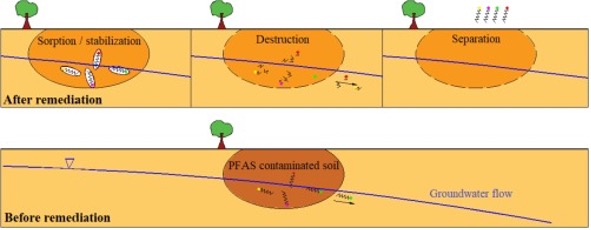The adsorption and desorption of PFAS to and from soil affects the transport of PFAS into the environment via the groundwater flow. Absorption is regulated by two mechanisms: the interaction of soil organic matter with the hydrophobic tail of fluorinated carbon and the electrostatic interactions of the clay particles with the polar head group.
The content and properties of soil organic matter (SOM) play an important role in adsorbing hydrophobic organic contaminants.
If the SOM is relatively low (less than 1%), the mineral characteristics of the soil will be important in the adsorption of PFAS.
Prior to any treatment, a thorough understanding of soil conditions in the field is required to help engineers choose the most suitable remediation option. For example, through a geo-environmental survey, it is possible to determine the level of contamination and its distribution in the environment, including the source, the path and the final destination. This leads to the development of a robust conceptual site model (CSM), which helps to identify site risks as well as potentially applicable corrective alternatives.

Containment methods (sealing or encapsulation methods) involve the use of technologies to prevent pollution from leaving the initial site. Containment system components can be vertical and horizontal barriers (or linings) around, above and below contaminated soil. On-site containment, including excavation and placement in containment cells covered by coatings and impermeable material, has been used in the industry as a management option. The aim is to reduce infiltrations, isolate the impacted material and control infiltrations by means of an adequate drainage system. It should be remembered that this is a short-term solution and it is very difficult to ensure complete containment. In addition, the contamination will remain in the site and the degradation of the barriers, the change in water levels or any other disturbance could cause the contaminants to spread into the environment in the future, requiring additional treatment. The method requires continuous monitoring and long-term management.











